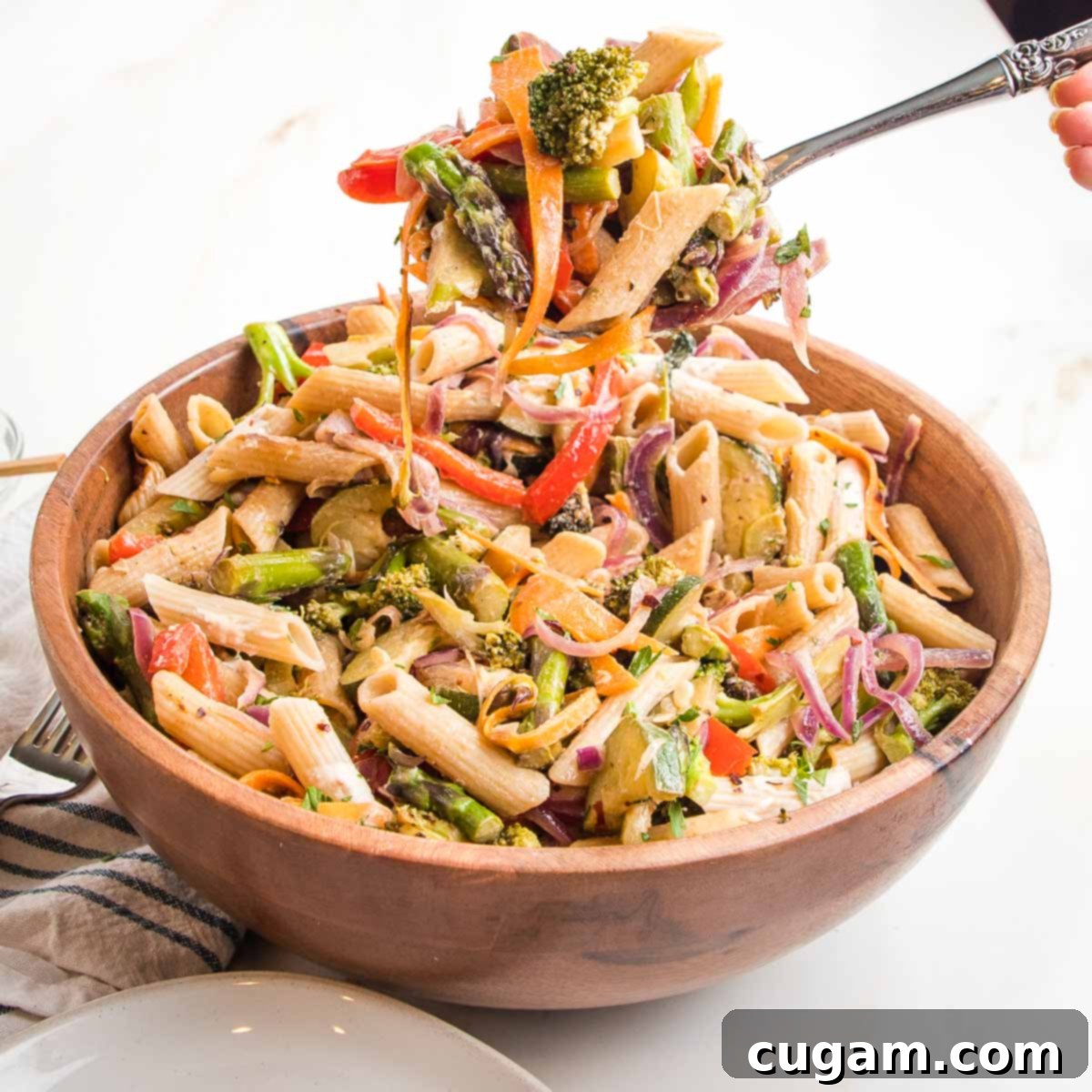The Ultimate 30-Minute Vegan Pasta Primavera with Creamy Tahini Lemon Sauce
Craving a quick, healthy, and incredibly flavorful meal? Look no further than this vibrant Vegan Pasta Primavera Recipe! It’s the perfect solution for a busy weeknight, delivering a wholesome dinner packed with fresh, seasonal vegetables and coated in a light, zesty lemon tahini sauce. The best part? You can whip up this delightful plant-based dish in under 30 minutes, making it an instant year-round favorite for the whole family.
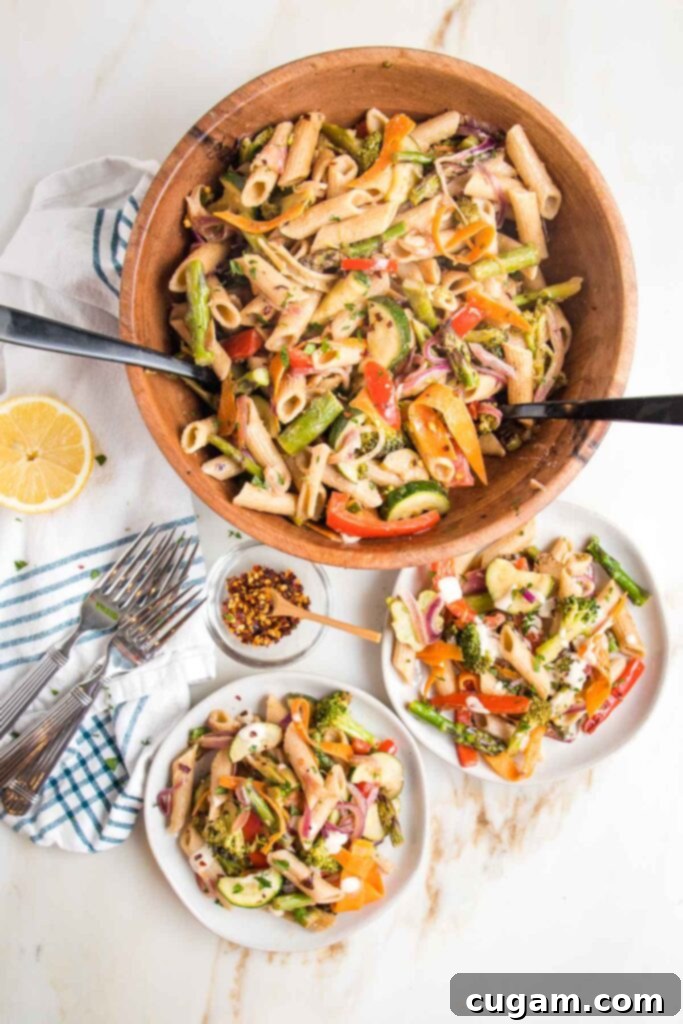
While “primavera” traditionally evokes spring, this healthy pasta dish transcends seasons. It’s an exceptionally delicious way to incorporate a colorful array of your favorite fresh vegetables into your diet, no matter if it’s the peak of summer or the chill of autumn. Its versatility makes it a staple in any healthy kitchen.
Unlike traditional pasta primavera that often features a heavy lemon cream sauce, our dairy-free rendition offers a beautifully light and refreshing flavor profile. We achieve this with a unique vegan primavera sauce base of white wine and creamy tahini, creating a rich yet airy texture that everyone, even omnivores, will absolutely adore.
If you’re on the hunt for an easy, plant-based dinner that doesn’t compromise on taste and can be on your table in less than half an hour, your search ends here. This recipe promises a satisfying and wholesome meal that’s both simple to prepare and bursting with incredible flavor.
Why You’ll Adore This Vegan Pasta Primavera
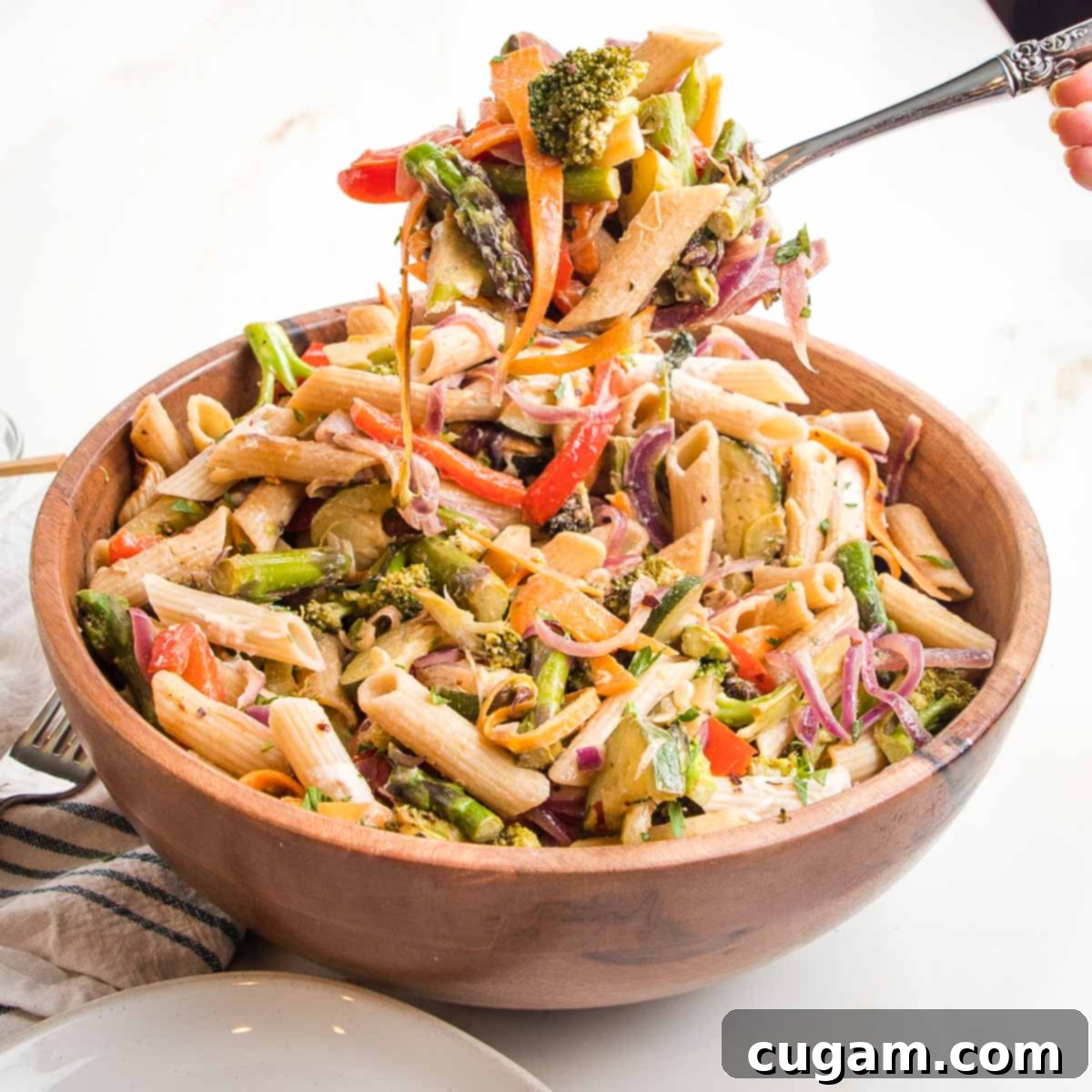
- Perfectly Balanced: This dish is both light and incredibly filling. You’ll be amazed by how satisfying this dairy-free, lemon-infused sauce is without feeling heavy. It’s the ideal balance for a guilt-free yet indulgent meal.
- Nutrient Powerhouse: It’s a super tasty and efficient way to boost your daily intake of nutrient-packed vegetables. Each bite delivers a vibrant mix of vitamins, minerals, and fiber, making it truly good for you.
- Ultimate Vegan Comfort Food: Experience pure satisfaction with this healthy take on comfort food. The pasta you crave is perfectly balanced with an abundance of fresh vegetables and a delectable vegan sauce. If you’re a fan of nourishing vegan pasta dishes, you might also enjoy our vegan pesto pasta salad or my savory sesame noodles with crisp veggies.
- Irresistibly Plant-Based: This meal is so incredibly good, it will win over even the most dedicated meat-eaters. It’s proof that plant-based eating can be exciting, flavorful, and deeply satisfying.
- Bursting with Flavor: Every single forkful is a celebration of taste. The harmonious blend of fresh ingredients and aromatic seasonings creates a truly memorable culinary experience.
- Visually Stunning: We eat with our eyes first, and this dish is a feast for them! Its gorgeous, colorful presentation makes it as appealing to look at as it is to eat, making mealtime a joyful occasion.
Essential Ingredients for Your Creamy Tahini Lemon Sauce
The secret to this primavera’s irresistible flavor lies in its incredibly light, creamy, and dairy-free tahini lemon sauce. Here are the key ingredients you’ll need to create this culinary magic:
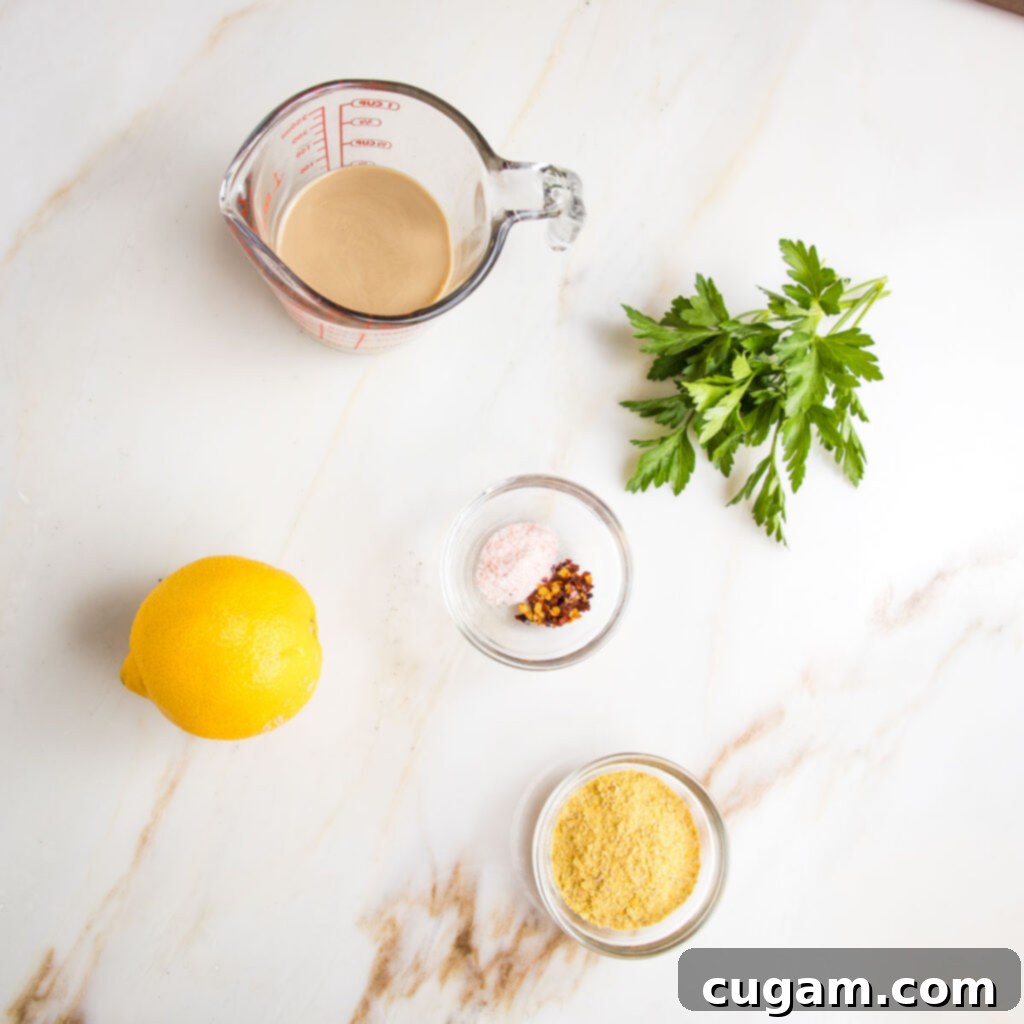
- Tahini: This sesame paste is a fantastic base for oil-free or low-oil pasta sauces. Not only does it create a wonderfully creamy, dairy-free texture, but it’s also a whole foods ingredient packed with antioxidants and calcium, known for its inflammation-lowering properties. Choose a good quality, smooth tahini for the best results.
- Fresh Lemon: For an explosion of citrus flavor, we’ll use both the zest and the juice of a fresh lemon. The lemon juice is crucial for keeping the primavera sauce bright, light, and incredibly refreshing, cutting through the richness of the tahini beautifully.
- Salt & Pepper: Seasoning is key! We use coarse sea salt to enhance all the flavors. If you’re mindful of sodium intake, consider reducing the amount or opting for a no-salt seasoning blend. Always start with less and adjust to taste at the end. Crushed red pepper flakes add a delightful “zing” and a hint of warmth that I personally love, but you can easily substitute with freshly cracked black pepper if you prefer a milder spice.
- Nutritional Yeast: This magical ingredient provides a wonderful vegan “cheesy” flavor. I like to sprinkle it generously on top of the finished dish for an extra layer of umami. Alternatively, you can whisk some directly into the sauce along with the other ingredients for an integrated cheesy note.
- Fresh Herbs: The bright, herbaceous taste of fresh parsley is a perfect complement to this dish. It adds a pop of color and freshness. Feel free to get creative and chop up other fresh herbs like basil, oregano, or thyme to sprinkle on top for additional aromatic layers.
How to Make Your Perfect Vegan Pasta Primavera
Preparation is key for this quick recipe! Before you begin cooking, make sure all your vegetables are prepped as described below. Since the veggies only require a quick sauté to achieve al dente perfection, having them uniformly cut and ready will ensure everything cooks evenly and efficiently.
Expert Tips for Prepping Fresh Veggies
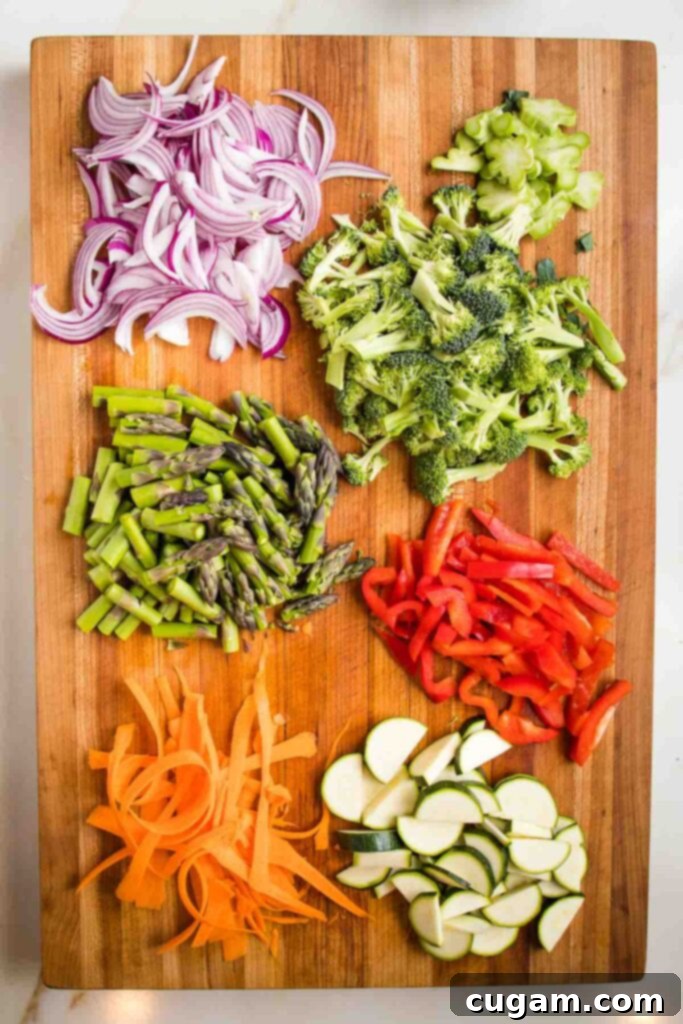
For the best flavor and texture, prioritize buying fresh, in-season vegetables. You can often find the most vibrant spring or summer vegetables at local farmers’ markets or your local grocery store. A crucial tip for even cooking is to cut your vegetables into similar sizes. Also, pay close attention to the thickness of your cuts, as this will significantly impact their cooking time.
You’ll want a minimum of 5 cups of fresh, chopped vegetables for this recipe to ensure a hearty and nutrient-rich dish. Here’s how to prep each:
- Red Onion: Begin by cutting the red onion in half, then peel off any tough outer layers. For stability and safety, place the onion cut-side down on your cutting board, and then slice it into thin, elegant strips.
- Asparagus Spears: First, snap or cut off the woody ends of the asparagus. These tougher ends are not pleasant to eat. Once trimmed, cut the spears into 1-inch pieces.
- Carrots: Peel the carrots and trim off their ends. For quick cooking and a delicate texture, use a vegetable peeler to create long, thin ribbons. If you prefer to cut them into ¼-inch discs, just remember they will require a slightly longer cooking time.
- Fresh Broccoli: If your broccoli stalks are particularly long, slice them into thin discs and add these to the pan early on as they take longer to soften. Use a sharp knife to cut the florets from the crowns into similar, bite-sized pieces for even cooking.
- Red Bell Pepper: Any color bell pepper will work beautifully, so use what you have on hand or even a mix for extra color! Cut a thin sliver off the top and bottom, remove the seeds and white pith, then slice the sides into thin strips.
- Zucchini or Yellow Squash: Opt for long, thin summer squash varieties, as the rounder ones often contain more seeds and can be slightly more bitter. Trim a thin slice off both ends, then slice the squash in half lengthwise before cutting into ¼-inch half moons.
Once your vibrant array of vegetables is prepped and set aside, it’s time to get the pasta cooking. Bring a large pot of salted water to a rolling boil. Add your chosen pasta and cook according to the package instructions, but with one crucial adjustment: set your timer for 2 minutes LESS than the directed cooking time. This is particularly important for gluten-free pasta, which can become mushy if overcooked. We are aiming for perfectly al dente pasta – firm to the bite – ensuring it doesn’t get gummy and stick together.
Choosing the Best Pasta for Your Primavera
The beauty of pasta primavera is its adaptability, and that extends to your choice of pasta! In this recipe, I utilized Jovial Gluten-free Brown Rice Penne. However, don’t feel limited! Linguine or even pad thai noodles can work wonderfully for a different texture. Fusilli is another excellent choice, as its corkscrew shape allows more of that delicious sauce to cling into its crevices, ensuring flavor in every bite. Yum!
Feel free to use whatever pasta shape you prefer and a variety that suits your dietary needs. Just remember our golden rule: always aim for al dente pasta in this recipe. Start testing for doneness about 2 minutes before the package directions suggest to achieve that perfect firm, yet tender, bite.
Crafting the Dreamy Vegan Primavera Sauce
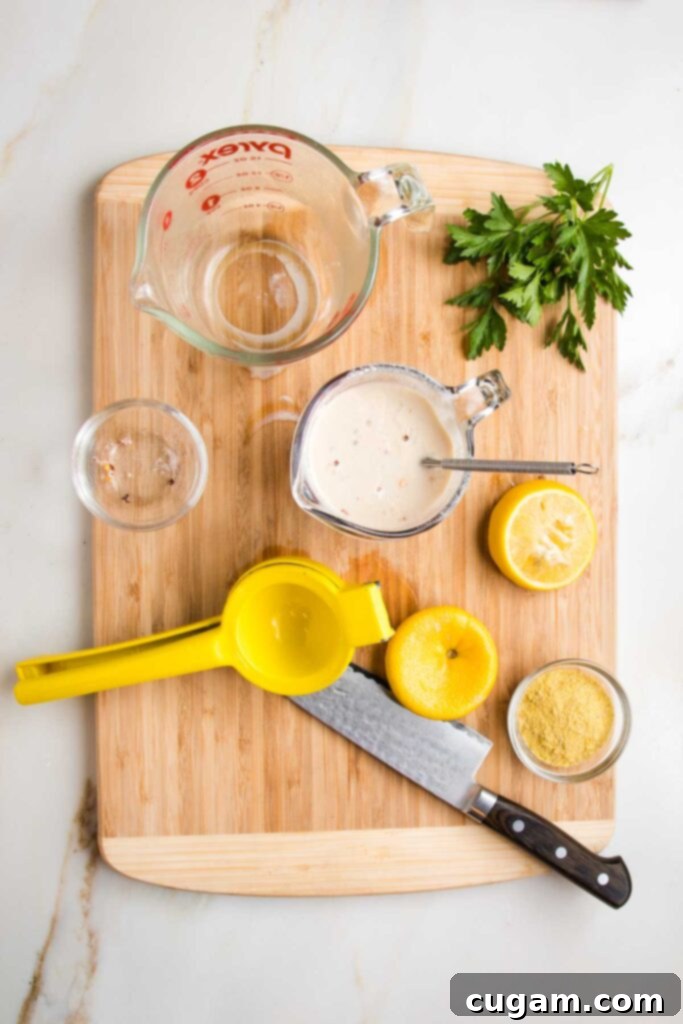
- To begin, in a medium bowl, vigorously whisk together the tahini, fresh lemon juice, salt, and crushed red pepper. The mixture will be quite thick at this stage.
- Next, carefully scoop out a cup of the hot pasta cooking water with a Pyrex glass measuring cup. Slowly whisk in about ½ cup of this starchy water into the tahini mixture. This will gradually thin out the sauce to a luscious, pourable consistency. Add more pasta water, one tablespoon at a time, if needed, until you reach your desired creaminess. Remember to save any remaining pasta water – it’s liquid gold for adjusting the sauce later!
- Finally, whisk in half of the nutritional yeast into the sauce. This infuses it with a subtle cheesy flavor. Reserve the remaining nutritional yeast to sprinkle on top as a garnish, along with your freshly chopped parsley, just before serving.
Now, let’s bring those veggies to life! Heat a large skillet (a cast iron skillet works wonderfully for even heat distribution) over medium-high heat. Swirl in 1 tablespoon of olive oil, vegetable broth, or a splash of your reserved pasta water to start the sauté process. Begin adding your prepped vegetables one at a time, starting with those that require the longest cooking time to ensure everything reaches the perfect tenderness simultaneously.
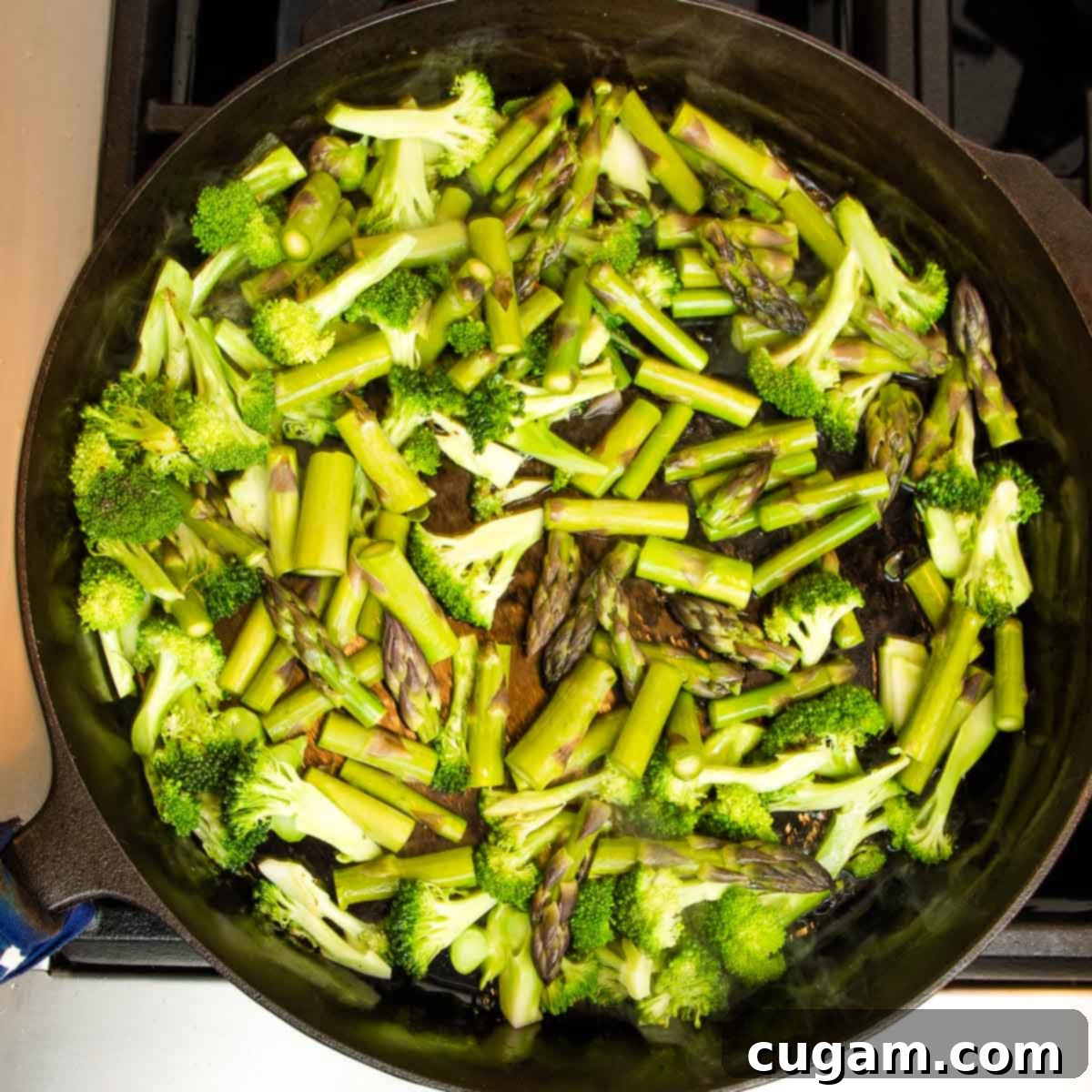
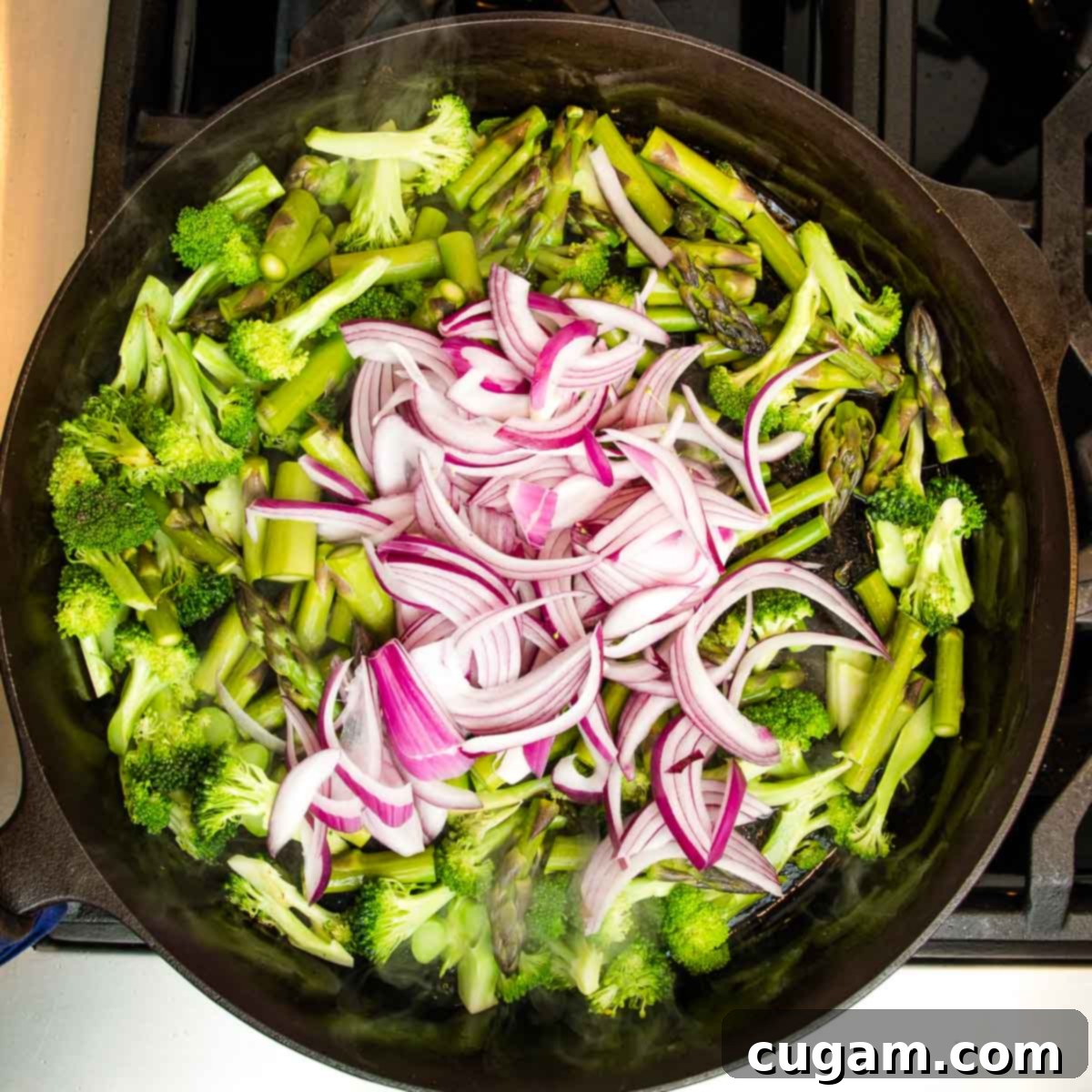
Following this order will help: first, add any thick broccoli stalk spheres, followed by thicker asparagus pieces. Allow them to cook for about one minute, stirring occasionally, before stirring in the thinly sliced red onions. If your pan starts to become dry during this process, don’t hesitate to add 1-2 tablespoons of white wine, vegetable stock, or more pasta water to deglaze the pan and prevent sticking. The white wine adds a lovely depth of flavor, though its alcohol will cook off.
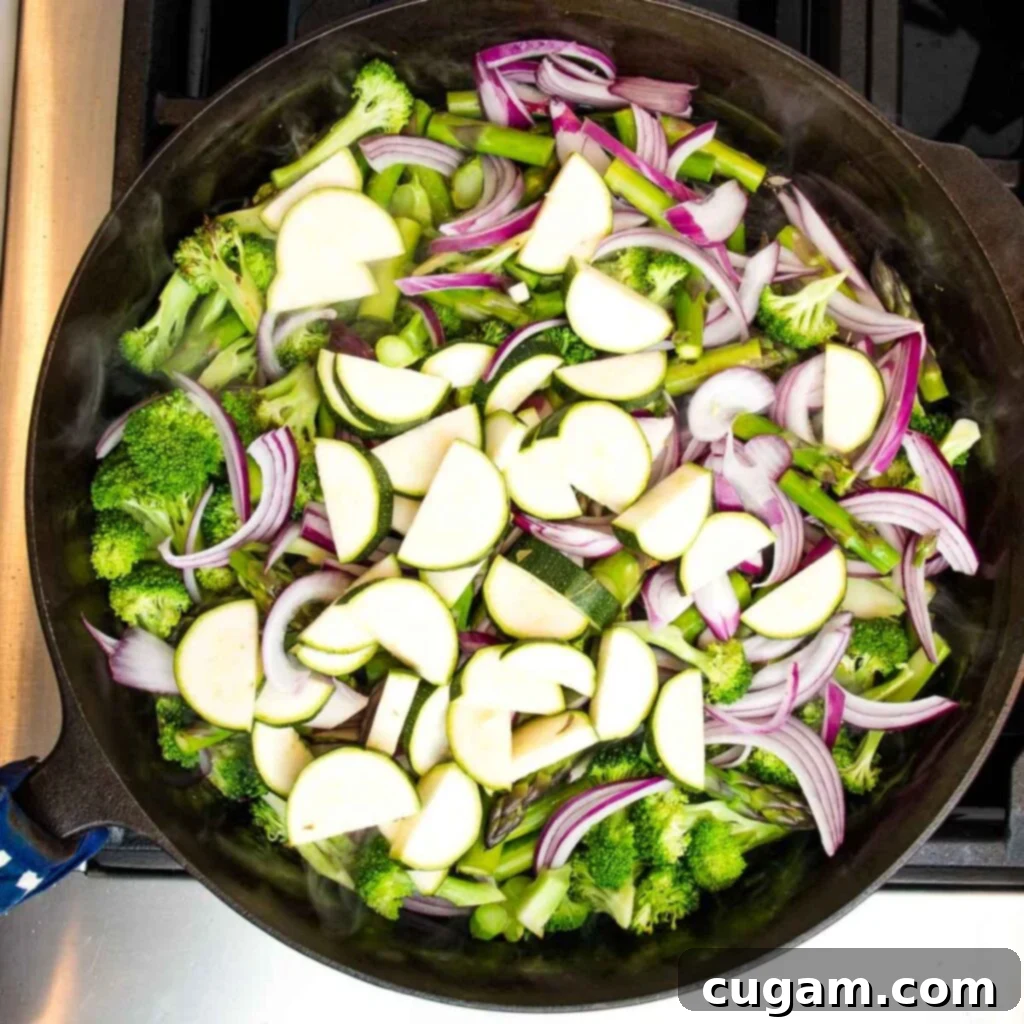
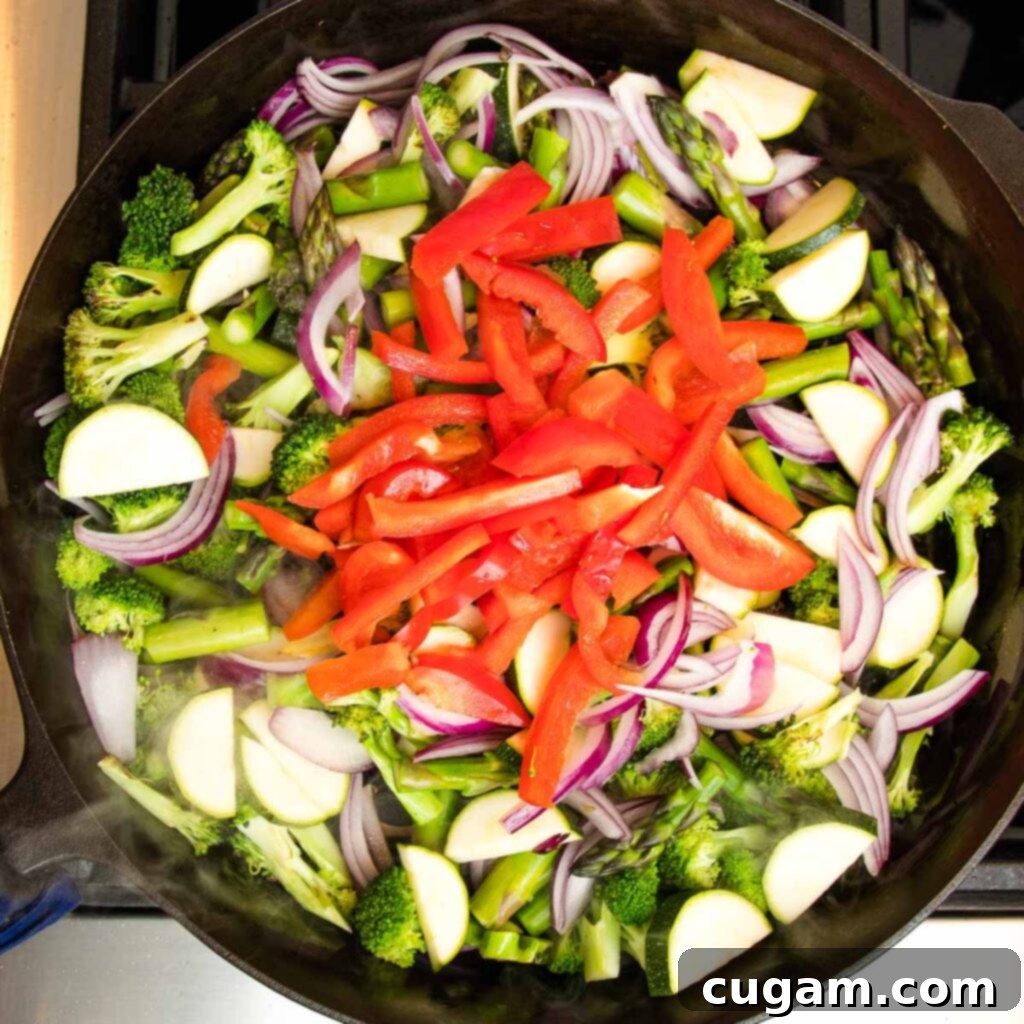
Next, introduce the zucchini half moons and red bell pepper strips. Toss everything thoroughly to ensure even cooking and distribution. Again, if needed, add another tablespoon of liquid – white wine or vegetable broth – to keep the vegetables from sticking and to encourage a gentle steam-sauté. While I enjoy the subtle flavor white wine imparts, if you prefer not to use alcohol, vegetable broth is an excellent and equally effective substitute.
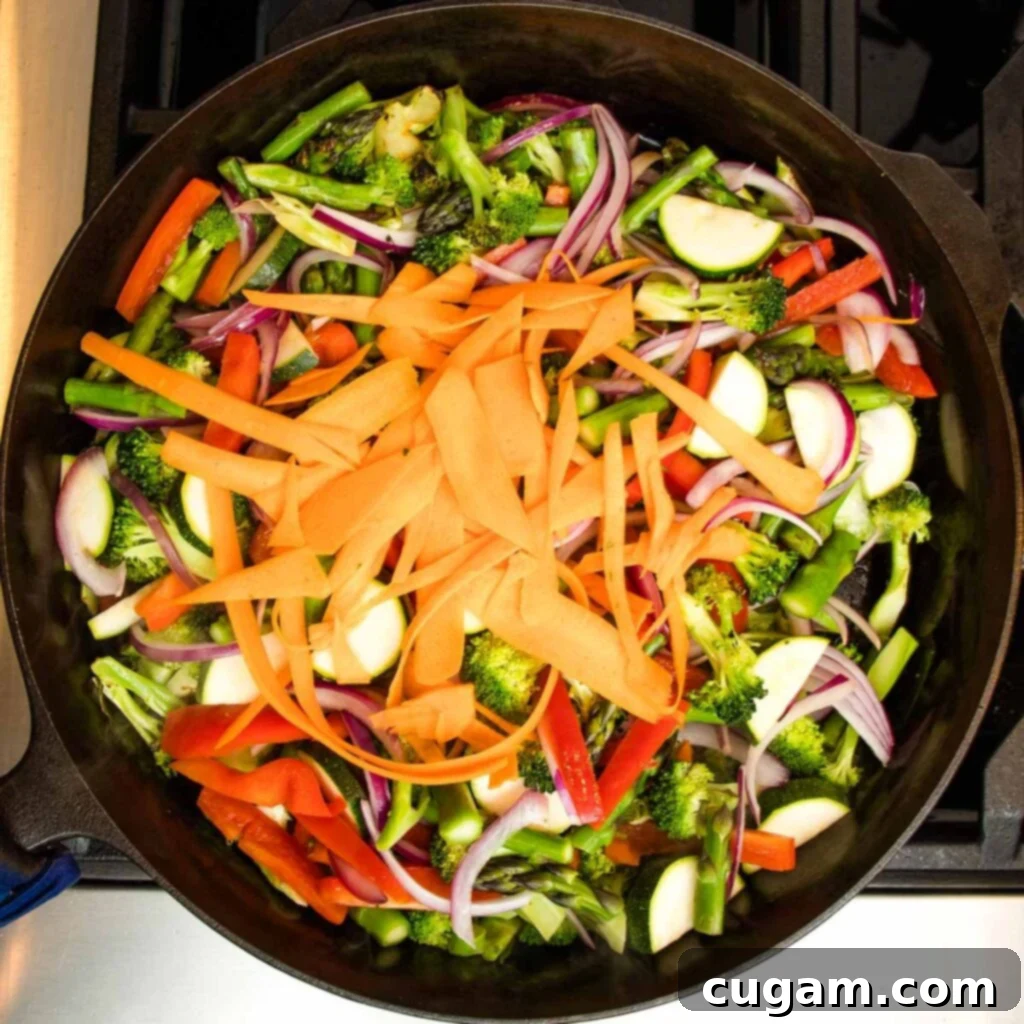
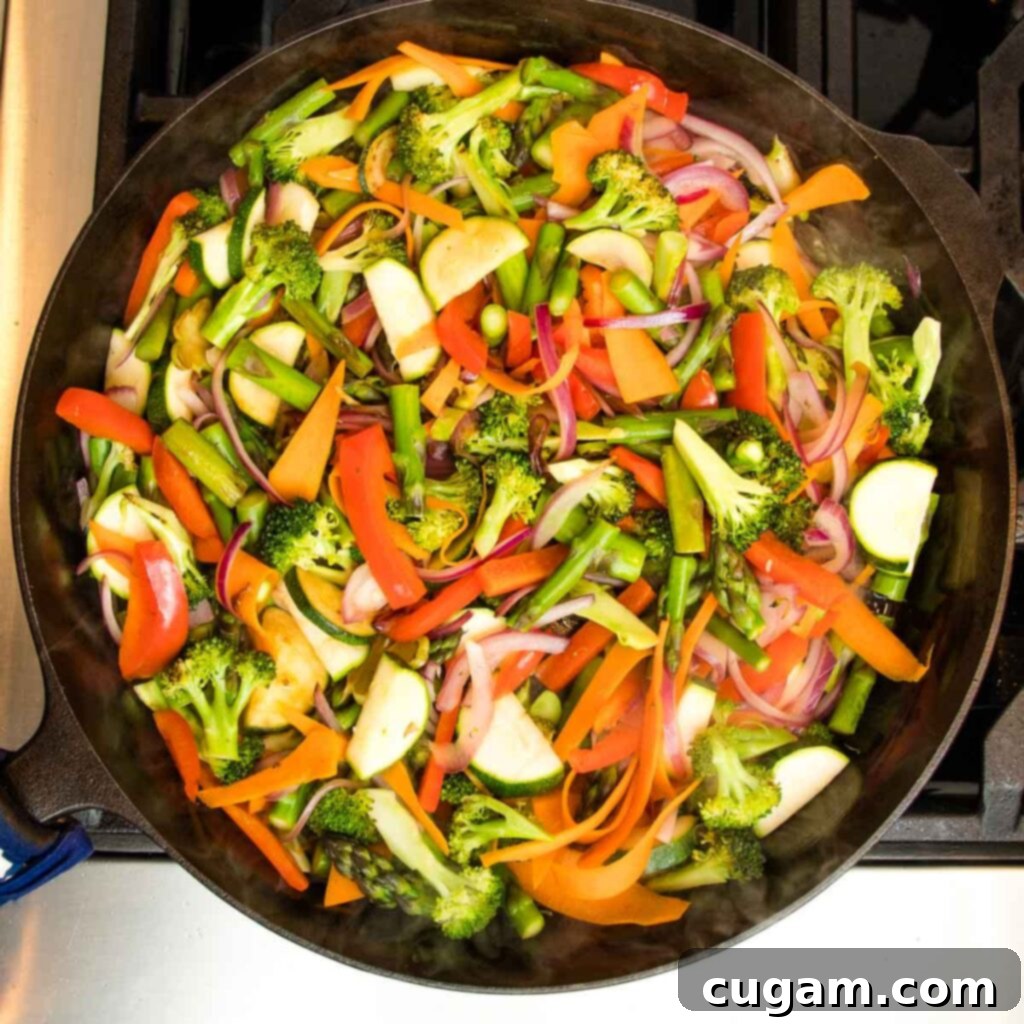
Finally, incorporate the delicate carrot ribbons into your colorful vegetable medley. At this stage, also sprinkle in 1 teaspoon of dried Italian seasoning. Continue to toss and cook for just another minute or two, until all the vegetables are bright in color and perfectly tender-crisp – not mushy. This maintains their delightful texture and nutritional value.
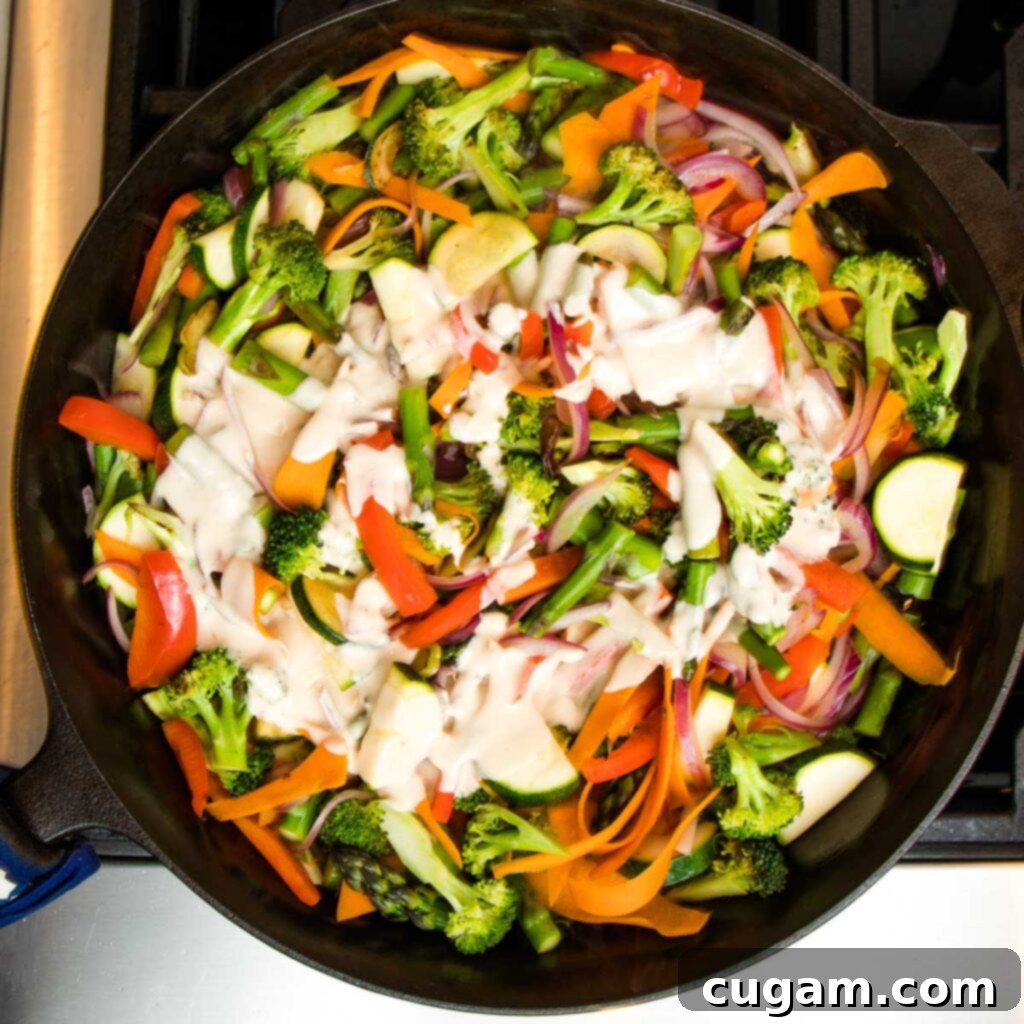
Once your vegetables are bright and tender, pour about half of your prepared tahini lemon sauce over them and stir well, ensuring every piece is coated in that creamy goodness. This initial coating adds a burst of flavor to the veggies themselves.
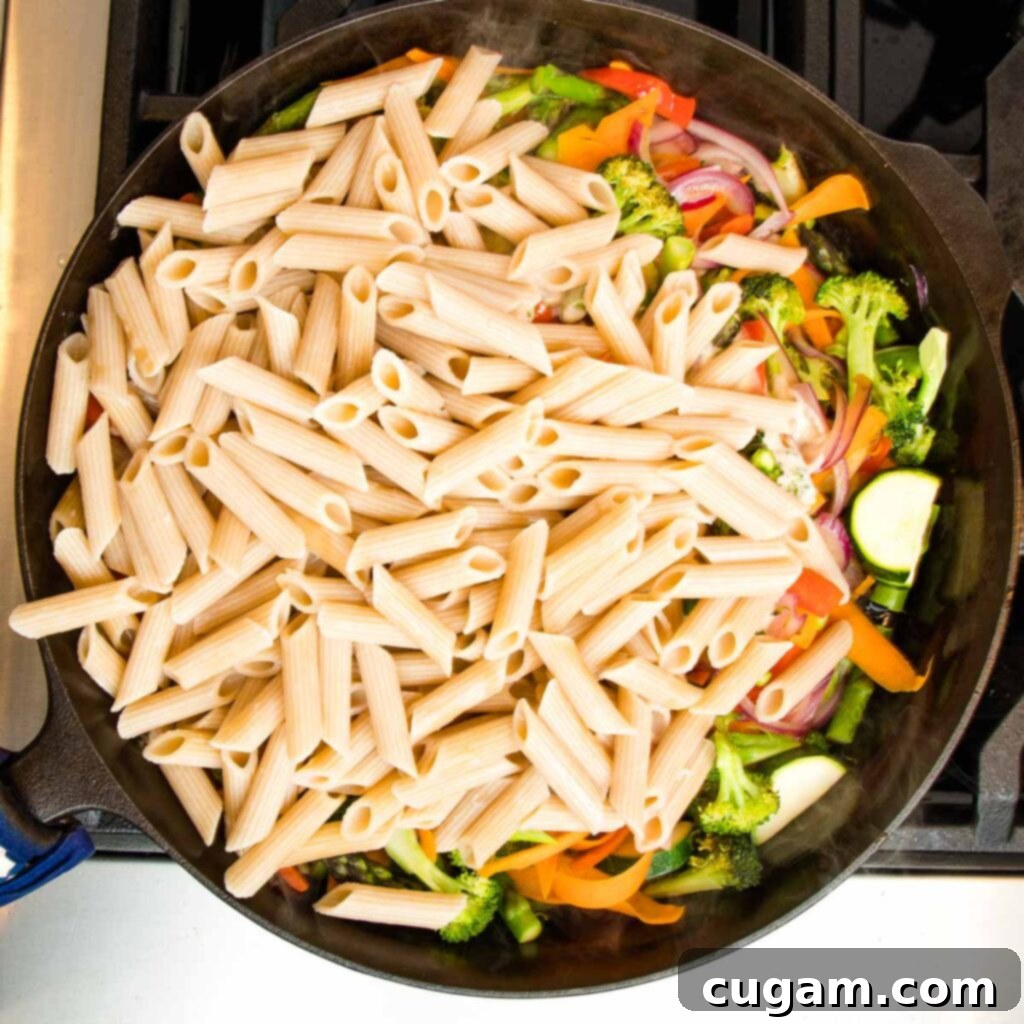
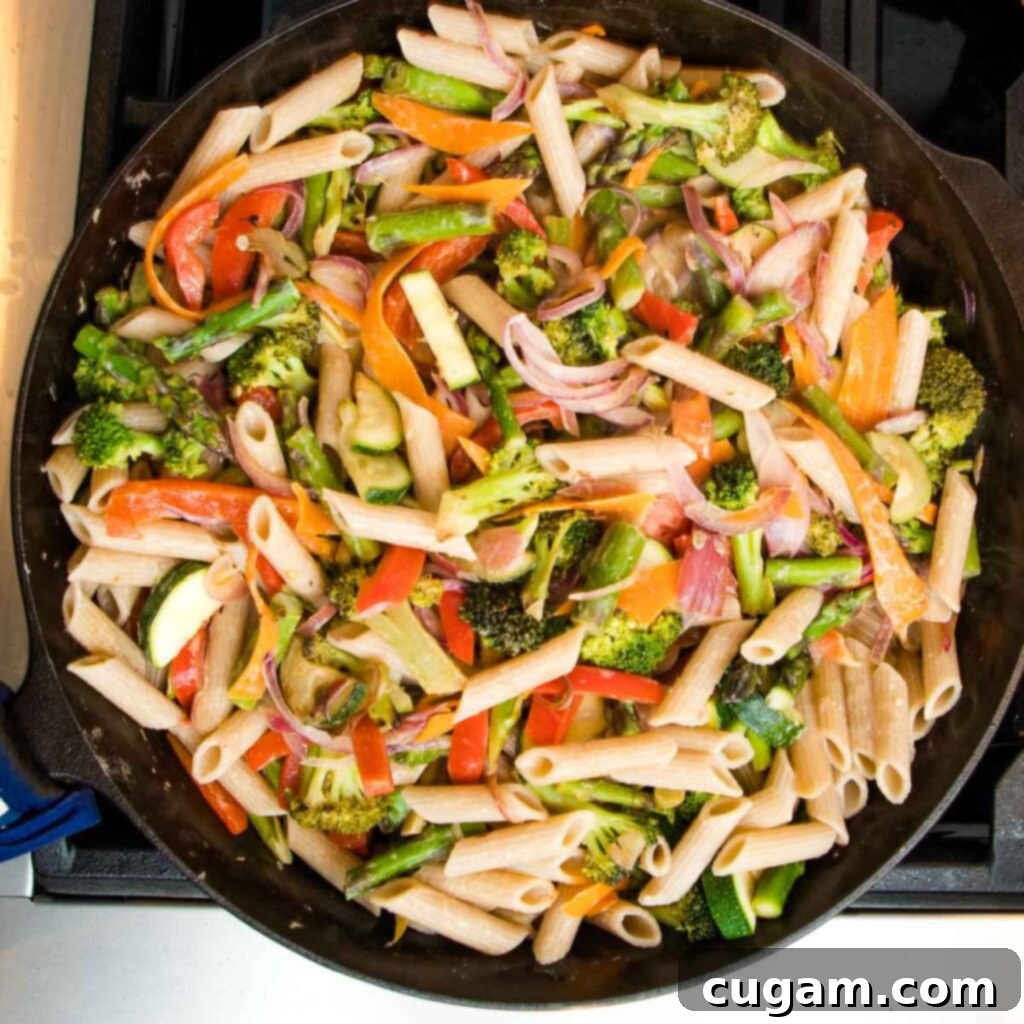
Now for the grand finale: the pasta! If your skillet is large enough, add the drained, al dente pasta directly to the vegetable mixture and toss everything together until the pasta is beautifully coated. If your pan is too full, simply transfer the vegetable mixture into the large pot you used to boil the pasta, then add the pasta and mix thoroughly. This ensures all the delicious flavors are evenly distributed throughout the dish.
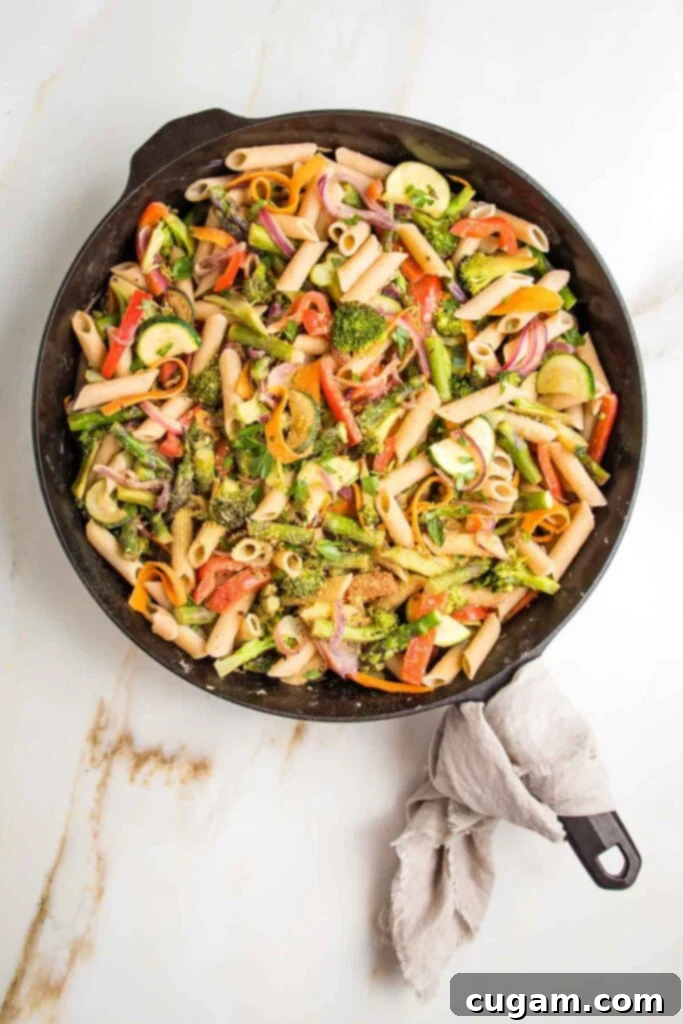
To serve, sprinkle on additional nutritional yeast for an extra “cheesy” touch, a generous handful of fresh chopped herbs (like parsley or basil), and a final squeeze of fresh lemon juice if you desire an extra bright note. Serve this delightful vegan pasta primavera warm, and for those who enjoy a little extra kick, pass around some additional crushed red pepper flakes. Enjoy!
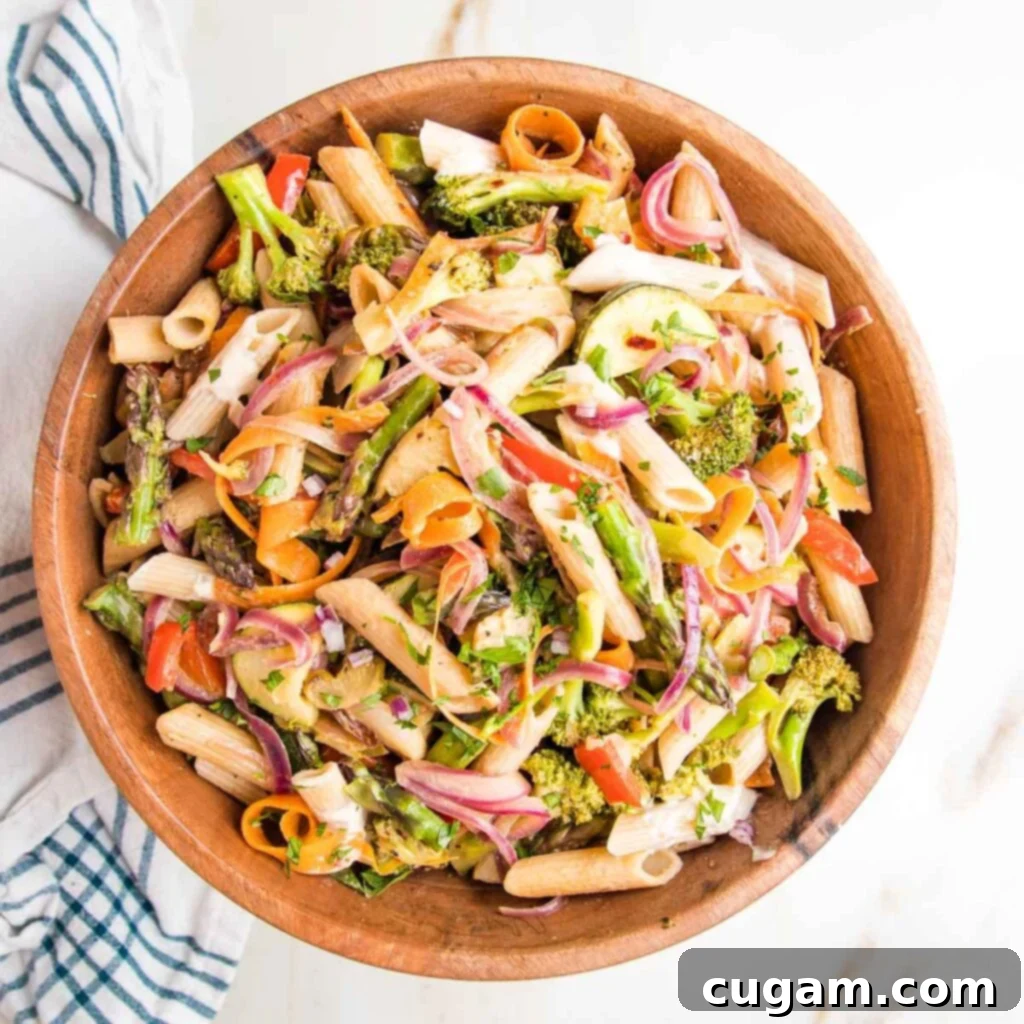
Meal Prep and Storage Tips
Make the most of your Vegan Pasta Primavera with these handy tips for serving, prepping ahead, and storing leftovers:
- Serving Suggestions: This recipe is designed to serve 4 as a satisfying vegan main dish, or it can serve 4-6 as a healthy and flavorful side dish. To stretch the meal even further, consider adding more veggies or incorporating small white beans for extra protein and bulk. While this recipe truly shines when served warm, its flavors are also fantastic enjoyed cold as a refreshing pasta salad, making it perfect for picnics or packed lunches.
- Prep Ahead: Streamline your cooking process by prepping ingredients in advance. All your vegetables can be chopped and stored in an airtight container in the refrigerator up to a day before you plan to cook. You can also prepare the primavera sauce up to 3 days in advance. When making the sauce ahead, use vegetable broth instead of pasta water to thin it, then store it in a lidded glass jar in the fridge. Before adding it to your tender veggies, warm the sauce gently and add a splash of pasta water or broth if it needs loosening.
- Storing Leftovers: Any leftover pasta primavera can be stored in an airtight container in the refrigerator for up to 5 days. For reheating, gently warm it on the stove in a heavy skillet over low-medium heat. To prevent it from drying out, add a splash of white wine, lemon juice, or vegetable broth while reheating to revive the sauce and maintain moisture.
- Freezing: Unfortunately, this dish doesn’t freeze particularly well. The fresh vegetables and delicate pasta tend to lose their optimal texture upon thawing. It’s truly best enjoyed freshly made or as a refrigerated leftover.
Debra’s Pro Tips for Perfect Pasta Primavera
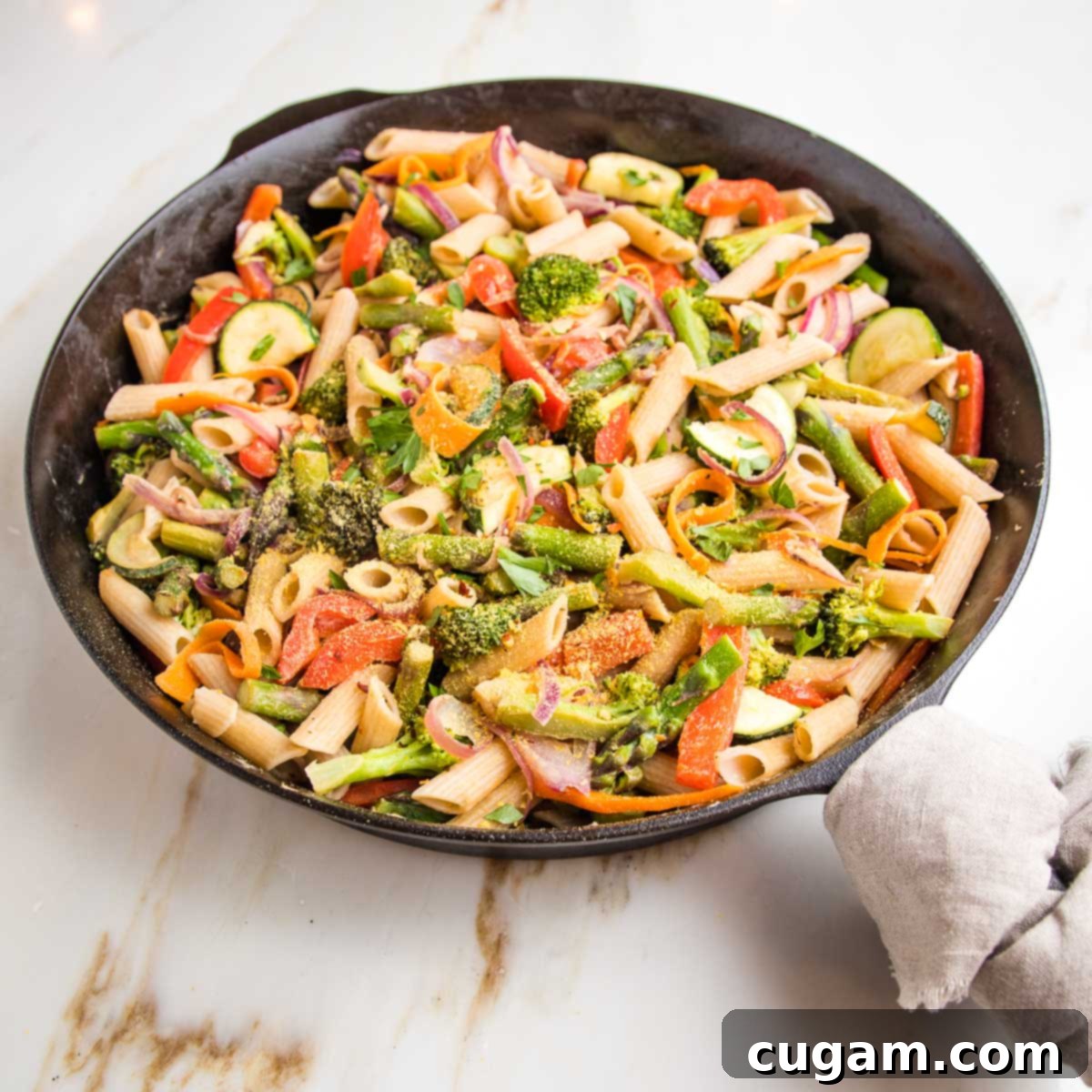
- Versatile Serving: This pasta primavera is wonderfully versatile. Serve it warm for a cozy dinner, or chill it and serve it cold as a refreshing pasta salad – perfect for summer potlucks or meal prepping lunches.
- Gluten-Free Excellence: “Does Gluten-free Pasta Primavera taste good?” ABSOLUTELY! Yes, embrace gluten-free pasta in this recipe, but keep a close eye on it to prevent it from getting mushy. A key trick is to set your timer for 2 minutes LESS than the package directions suggest to ensure it remains perfectly al dente.
- Strategic Veggie Sautéing: The order in which you add vegetables to the pan is crucial for achieving consistent tenderness. Always add harder, denser vegetables (like thicker broccoli stems or carrots cut into discs) first, as they require longer cooking times. Thinner pieces or quick-cooking vegetables (like super thin asparagus or carrot ribbons) should be added later, even at the very end, for that tender, al dente perfection. This ensures no vegetable is overcooked or undercooked.
- Flexible Vegetable Selection: Don’t feel bound by a strict list of vegetables. Using about 5 cups of assorted veggies gives you plenty of room to incorporate whatever fresh, seasonal produce you have on hand or what looks best at the market.
- Scaling Up: If you need to feed a larger crowd, this recipe scales beautifully! Simply double up on both the creamy sauce and the quantity of vegetables to ensure everyone gets a hearty and flavorful serving.
- Extra Sauce for Everyone: Some people just love extra sauce! Prepare a little more primavera sauce than the recipe calls for, and pass it around the table for those who prefer an extra luxurious coating. Any additional sauce can also be stored in the fridge and used to moisten and revive leftovers when reheating on the stove.
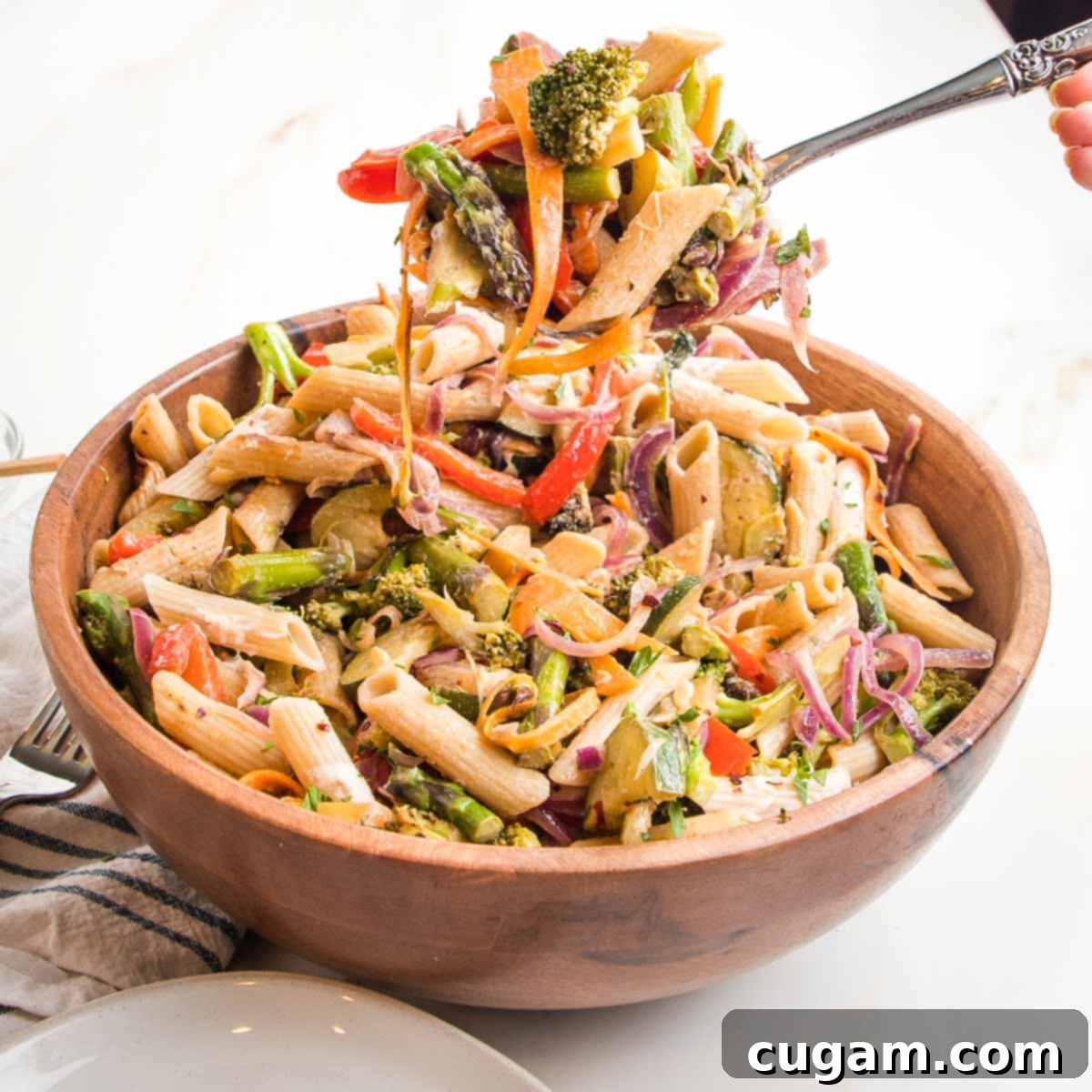
More Delicious Vegan Italian Main Dish Recipes:
If you loved this vegan pasta primavera, you’ll surely enjoy these other plant-based Italian-inspired main dishes:
- Vegan Zucchini Rollatini (gluten-free)
- Vegan Stuffed Peppers Lentils
- Meaty Vegan Stuffed Zucchini Boats
- Gluten-free and Vegan Vegetable Lasagna
Did you know commenting and rating recipes is one of the best ways to support your favorite food bloggers? If you made this recipe, please consider leaving a five-star rating below and a comment sharing your experience. Also, we’d love to see your creations! Please share your photos on Instagram by tagging me @dkhealthcoach and using the hashtag #debraklein. Your support means the world!
📖 Recipe
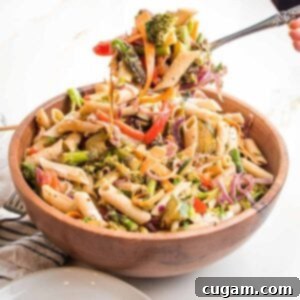
Vegan Pasta Primavera
Rate this Recipe
Pin Recipe
Equipment
-
Mini whisks
-
Cast iron skillet
-
Citrus Squeezers
-
Pyrex Glass Measuring Cup Set
Ingredients
- 1 lb. gluten-free pasta*
- 1 Tablespoon olive oil
- 1 medium red onion sliced thin
- 1 red bell pepper cut into thin strips
- 2 broccoli crowns cut into florets
- 1 medium zucchini cut into half moons
- 1 large carrot peeled into long, thin strips
- 1 bunch asparagus cut into 1″ pieces
- 1 teaspoon dried Italian seasoning
- 2-3 Tablespoons white wine
Pasta Primavera Sauce
- ¼ cup tahini
- 1 lemon juiced
- ½ teaspoon coarse sea salt
- ¼ teaspoon crushed red pepper
- ½ cup pasta water
Garnish
- ¼ cup chopped parsley
- 1 Tablespoon nutritional yeast
Instructions
-
PREP THE VEGGIES: Cut red onion in half and then thin strips. Stem and seed the red bell pepper and then chop into strips. Thinly slice stalk of fresh broccoli and then separate the top into florets. Trim ends off zucchini, slice in half lengthwise and then cut into ½” half moons. Trim and peel carrot, then use vegetable peeler to create long thin strips. Cut asparagus into 1″ pieces.
-
Bring a large pot of salted water to a rolling boil. Cook pasta according to package directions. Do not overcook. This easy pasta primavera tastes best when the pasta is cooked al dente. Generally, that will be 2 minutes LESS cooking time than the package instructions. Stir once or twice during cooking to prevent pasta from clumping together.
-
MAKE THE PRIMAVERA SAUCE: Whisk together tahini, lemon juice, coarse sea salt and red pepper flakes. Use a pyrex glass measuring cup to grab 1 cup pasta water. Pour ½ cup water into the creamy sauce and whisk well. If sauce is too thick, add a bit more pasta water, until cream sauce is pourable. Set aside.
-
Heat a heavy skillet over medium-high heat. Swirl in a little olive oil or pasta water. Start with just one Tablespoon. Add fresh vegetables in order one at a time: Broccoli, asparagus, red onion, zucchini, red pepper, carrots. Toss with large tongs in between, letting each cook for a minute before moving on. If pan becomes too dry during this process, add1-2 Tablespoons white wine or vegetable broth. Sprinkle on the Italian seasoning and continue to toss and cook until veggies are bright and still crisp.
-
Pour on half the sauce and stir well. If your pan is large enough, add the cooked pasta and mix well. Otherwise, drain the pasta and put it back into the pot it was cooked in and pour the veggie mixture onto the tender pasta. Mix well. Sprinkle with nutritional yeast, fresh parsley and taste for seasonings. Sprinkle on some sliced green onions or an extra squeeze of lemon juice to taste.
Notes
VEGGIES: The great thing about this easy vegan pasta primavera recipe is that it uses loads of fresh veggies and you can adapt those veggies depending on the time of year. I used fresh spring vegetables in these photos, but you can use whatever seasonal vegetables are available at your local grocery store. Other great additions to this classic Italian dish would be green beans, green peas, snow peas, snap peas, yellow squash, cherry tomatoes, fresh basil, or any other fresh herbs you have.
Nutrition
Note
The nutrition calculations were done using online tools. To obtain the most accurate representation of the nutritional information in any given recipe, you should calculate the nutritional information with the actual ingredients you used. You are ultimately responsible for ensuring that any nutritional information is accurate, complete and useful.
